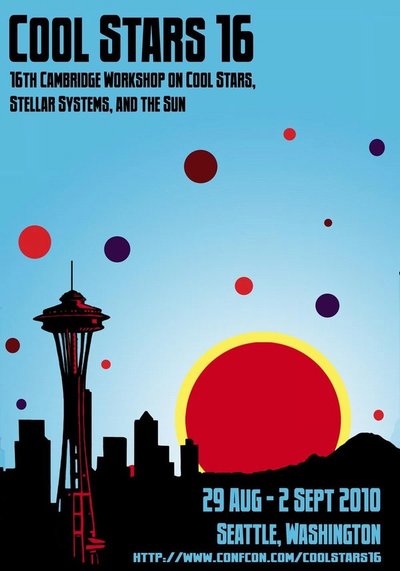August 23, 2010
Astronomy conference at UW to explore the sun and other cool stars
For many people, all stars are “cool.” But the 350 or so astronomers gathering for the Cool Stars 16 conference at the University of Washington next week are interested in stars such as our sun with surface temperatures of 5,700 degrees Celsius or less, compared to more than 30,000 degrees for the hottest stars.
Astronomers classify stars in seven letter categories. Cool stars are classified as G, which includes yellow stars like the sun, and two classes that are cooler still — K (orange) and M (red).
Cool stars make up more than 70 percent of the stars in our galaxy, but interest in them waned in the 1970s and ‘80s, when it was thought that they were well understood, said Suzanne Hawley, who heads the UW astronomy department and the scientific organizing committee for the conference.
But interest picked up again in the 1990s, Hawley said, with the first discovery of planets orbiting G stars in nearby systems. Since then, hundreds of extrasolar planets have been identified orbiting cool stars. The vast majority of those planets are gas giants like Jupiter and are not likely able to support life.
“If we manage to ever find another Earth-like planet around a G star, that gives us a place to go if Earth becomes uninhabitable,” she said.
NASA’s recently launched Kepler mission is aimed at hunting for new “Earths,” and has already provided numerous other scientific results on cool stars that will be featured at the conference.
Science sessions for the “16th Cambridge Workshop on Cool Stars, Stellar Systems, and the Sun” begin Sunday, Aug. 29, and conclude Thursday, Sept. 2.
In larger plenary sessions, scientists will discuss topics such as the formation and evolution of cool stars, their magnetic fields and their place in the galaxy. Smaller “splinter” sessions will include experts on topics such as habitability of planets orbiting cool stars and solar and stellar flares.
Interest in cool stars also has been fueled in recent years by the discovery of brown dwarfs, failed stars that produce low levels of heat and light but are too small to sustain nuclear fusion in their cores. Brown dwarfs range in size from about 13 to 80 times the mass of Jupiter, larger than planets but smaller than cool stars.
During the conference, scientists will discuss how cool stars and brown dwarfs can be used to understand the structure of the galaxy, with new observations made possible by large telescope projects such as the Sloan Digital Sky Survey and the Large Synoptic Survey Telescope.
The Sloan survey operates from the Apache Point Observatory in New Mexico and is making detailed maps of the night sky visible from the Northern Hemisphere. The Large Synoptic Survey, which plans to build a telescope in northern Chile to take continuous images of the southern sky, last week was endorsed by the National Research Council as the highest funding priority in ground-based astronomy. The UW is a founding partner in both projects.
###
For more information, contact Hawley at 206-543-2888 or slh@astro.washington.edu.
REPORTERS NOTE: To arrange to attend conference sessions, contact Sarah Garner in the UW Astronomy Department at 206-543-9590 or sterrs@astro.washington.edu.
The Cool Stars 16 program is available at http://www.confcon.com/coolstars16/program.php.

